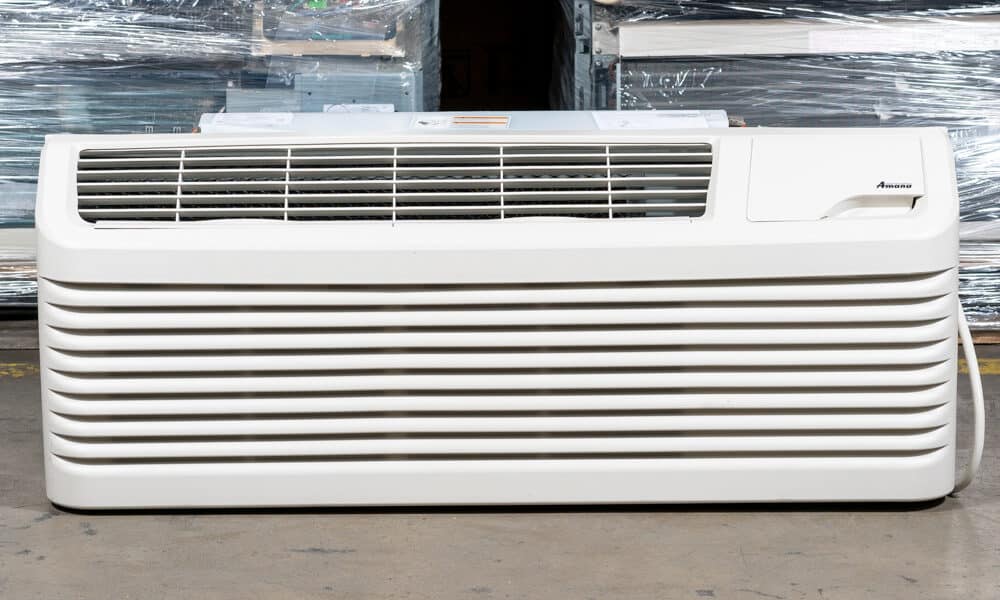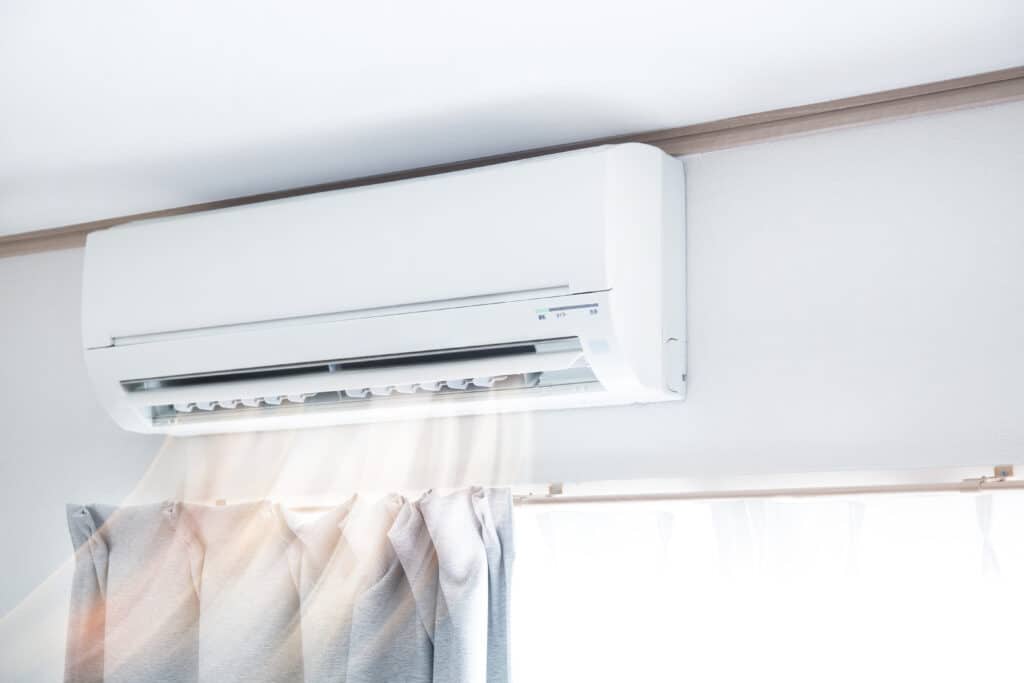When you want to control the temperature in smaller spaces like hotel rooms, one-room offices, and dorm rooms, there are two main options you’ll come across: Packaged Terminal Air Conditioner (PTAC) units and Mini Splits. Each comes with benefits and challenges that will dictate which one is better for your application. Let’s answer the questions “what is a PTAC unit” and “what is a mini split” to learn why you might choose one over the other.
What is a PTAC Unit?
So what is a PTAC unit exactly? PTAC AC units are entirely self-contained air conditioning systems installed through a standard-size 42″ wall cutout. These units have a simple plug for outlets ranging from 208 to 277 volts, making them inexpensive and quick to replace. Typically, PTAC AC units service a single room like a dorm room or small office but can be powerful enough to serve multi-room hotel suites. Aside from their ease of installation, replacement, and power, PTAC AC units often come with heater functions as well, making them a complete HVAC solution in a single piece of equipment.

So What is a Mini Split?
What is a mini split? And, when do mini splits make sense? Mini splits are ductless split system air conditioners that control indoor spaces without installing any ductwork. For older homes and additions where adding ductwork can be cost-prohibitive or physically impossible, mini splits can prove an effective solution for air conditioning when the weather warms up. Mini splits can also come with heater functions that work well for smaller spaces and single-room applications.
The most significant difference between PTAC units vs mini splits is that mini splits have two separate components, hence their “split” name.
While mini splits are ductless, they still have a separate heat pump compressor that sits outside much like a traditional HVAC system’s—it’s just smaller. You’ll still need refrigerant lines ran from outside to wherever the ductless blower unit will be placed, typically high on a wall and not easily reachable to clean the air filter.

Why Choose Mini-Splits Over PTAC Units?
While packaged terminal air conditioners and mini splits can have similar applications, there are some cases where one system is a better fit than the other. For applications where power consumption is a primary concern, mini splits are generally more efficient in this regard, making them a potentially less expensive option over time. That said, mini splits are more costly than PTAC units, so the energy savings will need to outweigh this.
Why Choose PTAC Units Over Mini Splits?
While energy efficiency is a benefit of mini splits, many times, PTAC units offer numerous advantages because they are one simple, cost-effective unit, unlike mini splits. No refrigerant lines are needed when installing new PTAC AC units, so a costly HVAC professional isn’t necessary. This fact alone can save considerable cost at the time of installation and whenever service is needed. If you need to purchase multiple units for buildings like hotels or office suites, these additional costs can add up fast, making PTAC units a superior choice over mini splits.
Convenience of maintenance
Since PTAC AC units are ductless, they’re much simpler to maintain. Because they come in a standard 42″ size, they can be simply unplugged and swapped out for a new unit when issues arise, saving considerable time and expense over having an HVAC professional make a costly service call.
Cost-effective
New PTAC AC units are less expensive to install than mini split systems because they don’t require HVAC professional installation. Once you have your power outlet in place and hole cut, you just slide the unit in, plug it in, and turn it on. No special mounting of heat pumps outside or fan units high on walls!
Complete heating and cooling control
Because they serve both heating and cooling roles, PTAC AC units offer complete control of the climate in a single room. This means no wasting energy on unoccupied spaces or affecting occupants in the rest of the building.
Are PTAC AC Units Right For Your Application?
Not all PTAC AC units are the same, and not all are right for every building. To find the best PTAC AC units for your needs, let’s take a closer look at factors to consider while perusing PTAC units for sale.
Location
Are you in an area where it’s hot all year, or do you need PTAC AC units that serve as heating systems too? If you live in a region with four seasons, you’ll want to look at PTAC AC units that provide enough BTUs for the complete heating and cooling of your space. If winters are very cold but summers are mild, you may need more heating BTUs than cooling, so don’t look at just the BTU needs of the cooling function when searching PTAC units for sale.
Square footage of the space
When browsing PTAC units for sale to install at your construction project or replacing existing PTAC AC units, consider the room’s square footage. The square footage dictates how many BTUs the unit requires to efficiently cool or heat the space. More space needs more BTUs, and you’ll want to purchase higher-BTU PTAC AC units if your rooms encounter more extreme temperatures.
Noise Level
Some units are quieter than others, so it’s wise to read reviews to get a sense of how much noise you can expect in your space. If noise is a primary concern, mini splits might be an option to consider, as PTACs are generally noisier than mini splits. That said, higher-end PTACs strike a good balance between budget and noise.
System Voltage
If you’re shopping for residential PTAC units, the voltage will be 208/240. Your PTAC AC units might require 265/277 volt if you’re shopping for a commercial space. Look at the type of wall outlet you have to determine what you’ll need when shopping for PTAC units for sale.
Amps and Electrical Cords
Check the amp supply to the power outlet for your PTAC unit on your electrical panel to determine how many amps your PTAC unit will be supplied with. This number will range between 15, 20, or 30 amps. This figure determines which power cord your unit will have, but some manufacturers let you specify the type of cord needed when purchasing.
Pricing of PTAC Units
When shopping for PTAC AC units, the cost can play a significant role in your decision, especially when buying multiple units at a time. The total price per unit will depend on numerous factors, including the brand of the PTAC unit, how powerful it is, and how quiet it is. Don’t forget to factor in the cost of PTAC unit accessories like external grills and wall sleeves.
Energy Efficiency
Also, remember to keep energy consumption in mind. Some PTAC AC units use considerably more energy than others, which is a cost that can add up if you’re installing numerous units in a hotel. Energy-efficient models may cost more upfront, but the total savings may be worth it long term.
Unit Durability and Warranty
When investing in PTAC units, it’s wise to ensure your purchase will last as long as you need. Be sure to read reviews and look up how long the warranty is.
If you need affordable PTAC AC units backed by warranty coverage, PTAC4Less sells refurbished PTAC AC units that we guarantee. Our warranty-backed units are professionally restored by PTAC unit experts, enabling you to get high-quality PTAC units at a great price with peace of mind.
Where can you find PTAC units for sale online?
After carefully considering PTAC AC units vs mini splits for your air conditioning needs, where might you shop for the best option to heat and cool your rooms? PTAC4Less sells new and refurbished PTAC units that you can have delivered and installed quickly. If you want to save money while enjoying the advantage of warranty coverage, look no further than PTAC4Less! Call or search our website to find your perfect solution for sourcing PTAC units today.
